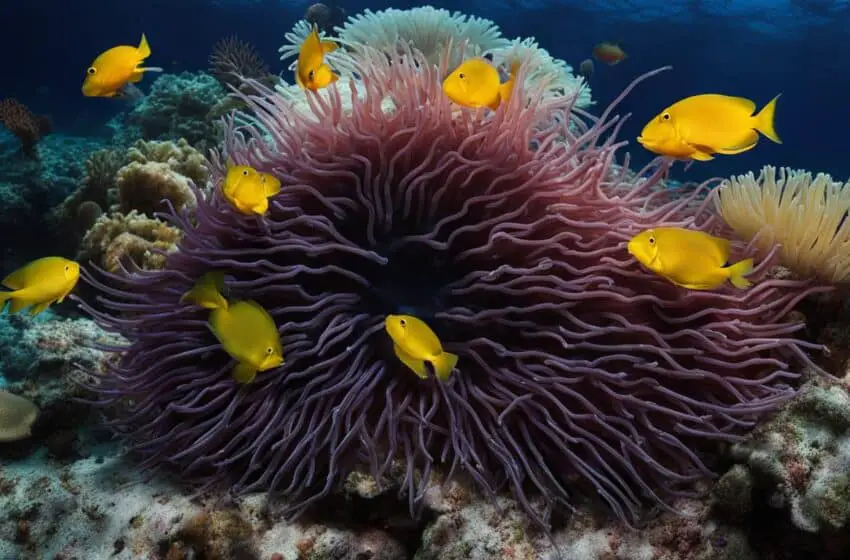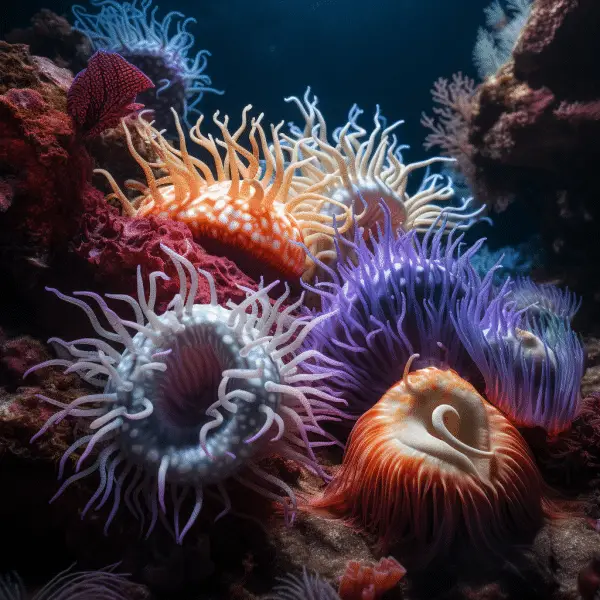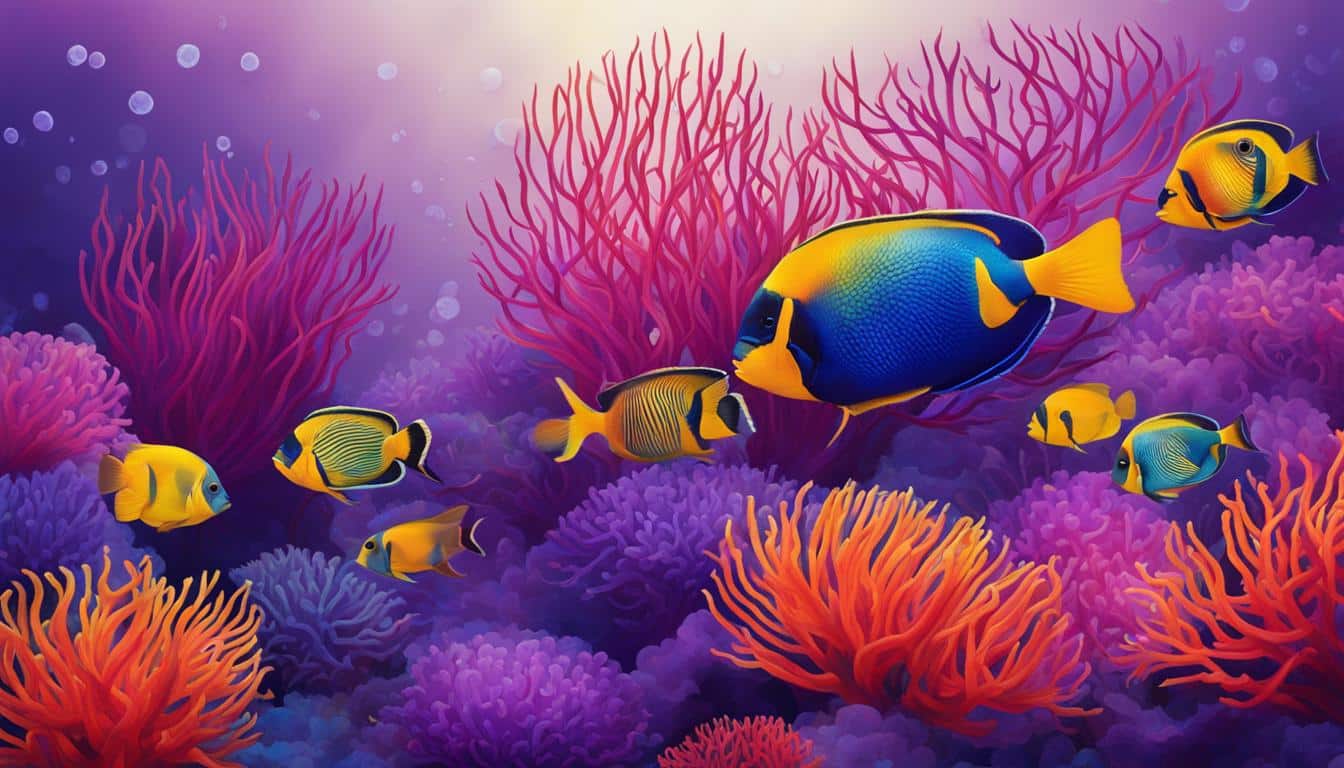Sea Anemone Predators And Mutualistic Marvels Unveiled

As a marine journalist, I have always been fascinated by the intricate ecosystem that exists within our oceans. Today, I want to take you on a deep dive into the world of sea anemones and their natural enemies. These fascinating creatures, with their delicate tentacles swaying in the currents, are not as defenseless as they may seem. They have an arsenal of predators that they must defend against to survive in their watery homes.
The starlet sea anemone, scientifically known as Nematostella vectensis, possesses a unique defense mechanism that rivals even the most advanced technologies. Its stingers, which function like harpoons, are capable of striking predators or capturing prey in just a hundredth of a second. Imagine being able to react that quickly!
These stingers, propelled by pressurized capsules, extend and turn inside out upon contact, releasing a venomous thread with barbs that pierce into the predator’s soft tissue. What makes this defense mechanism even more fascinating is that each stinger is only good for a single use. It’s a true “one-hit wonder” in nature.
Key Takeaways:
- Sea anemones have natural enemies that they must defend against to survive.
- The starlet sea anemone has an impressive stinger mechanism, functioning like a harpoon.
- The stingers extend and turn inside out, releasing venomous barbs into the predator’s soft tissue.
- Each stinger can only be used once, making it a “one-hit wonder.”
- This defense mechanism showcases the incredible adaptations found in marine ecosystems.
Join me as we continue our exploration into the amazing world of sea anemone predators and the intricate relationships that shape marine ecosystems.
Mutualistic Relationship between Anemones and Fish

Sea anemones, known for their vibrant colors and graceful tentacles, engage in a fascinating mutualistic relationship with certain species of fish. This unique partnership provides benefits for both parties involved, showcasing the intricate web of interactions within marine ecosystems.
Research conducted by the University of Delaware has shed light on the dynamics of this relationship. Smaller-bodied fish find refuge among the tentacles of sea anemones throughout their lives, utilizing them as a form of protection from predators. These fish benefit from the anemone’s stinging cells, which deter potential threats in their environment and provide a safe haven.
Conversely, larger-bodied fish associate with sea anemones during their juvenile stage. The anemone’s tentacles offer protection to these young fish, shielding them from predation until they grow in size and are better equipped to defend themselves. This association allows the fish to survive the vulnerable period of their life cycle and increases their chances of reaching adulthood.
This mutualistic relationship between anemones and fish is driven by predation. Smaller fish are more likely to fall prey to predators, while larger fish can fend for themselves more effectively. Anemones benefit from hosting and protecting these small reef fish as they gain access to additional nutrition and increased aeration. This symbiotic partnership highlights the intricate balance of nature and the interdependence of marine organisms.
Mutualistic Relationship between Anemones and Fish
| Benefits to Sea Anemones | Benefits to Fish |
|---|---|
| Access to additional nutrition | Protection from predators |
| Increased aeration | Survival during vulnerable life stages |
This mutualistic relationship has fascinated researchers, showcasing the complex interactions that shape coral reef ecosystems. The coexistence of anemones and fish demonstrates the importance of predation in ecological dynamics and provides valuable insights into the functioning and stability of marine environments.
As scientists continue to explore the intricate relationships within marine ecosystems, the mutualistic bond between anemones and fish stands as a testament to the remarkable adaptations and interdependencies found in nature’s underwater realms.

Conclusion
The starlet sea anemone’s sophisticated stinging mechanism and amazing defense plan against predators have been illuminated by the predator study. The sea anemone’s barb-tipped stingers paralyze predators and grab prey quickly. This unusual adaption shows nature’s micromachines’ speed and precision.
The mutualistic interaction between coral reef anemones and fish has shown how predation shapes ecological dynamics. Smaller fish use anemones for cover throughout their lives. Juvenile larger fish use anemones for predator protection. This mutually beneficial arrangement helps anemones survive by providing nutrients and aeration.
The complex interactions between sea anemones and their predators reveal coral reef ecosystem dynamics. It emphasizes predator-prey dynamics and marine habitats’ intricate relationships. Fish-anemone mutualisms have evolved several times across fish families over millions of years, emphasizing their relevance.
Sea anemone predators, as natural adversaries, are vital to marine ecosystems. They greatly influenced the biological landscape. By examining these linkages, we learn more about coral reefs and the need to conserve these fragile but lively underwater habitats.
FAQ
How do the stingers of starlet sea anemones function?
The stingers of starlet sea anemones function like harpoons with venomous barbs. They are one of the fastest micromachines in nature, jabbing predators or capturing prey in just a hundredth of a second. The stingers explode out of pressurized capsules, extending and turning inside out to release a venomous thread with barbs that pierce into the predator’s soft tissue. Each stinger is only good for a single use, making it a “one-hit wonder.”
What is the relationship between anemones and fish on coral reefs?
Research from the University of Delaware has revealed a mutualistic relationship between anemones and fish on coral reefs. Smaller-bodied fish associate with anemones throughout their lives as a form of protection from predators. Larger-bodied fish, on the other hand, associate with anemones as juveniles. Predation drives this relationship, as predators tend to target smaller fish. Anemones benefit from hosting and protecting these small reef fish by gaining access to nutrition and increased aeration.
How does the study on sea anemone predators contribute to our understanding of marine ecosystems?
The study on sea anemone predators reveals the intricate stinger mechanism of the starlet sea anemone and how it functions as a defense against predators. Additionally, the mutualistic relationship between anemones and fish highlights the role of predation in shaping ecological dynamics on coral reefs. Understanding these relationships provides valuable insights into the functioning and stability of coral reef ecosystems. Further research on the evolutionary history of fish-anemone mutualisms shows that it has developed on multiple occasions across various fish families over millions of years. Overall, the predators of sea anemones play a crucial role in the complex web of interactions in marine ecosystems.



